Portsmouth
In 1898 Royal Artillery FC kicked out of the Southern League after breaching the strict rules on amateurism of the period. The Army club attracted considerable support and had reached the First Division of the Southern League. To preserve first class football in the town, five prominent local sportsmen and businessmen formed Portsmouth FC who wore distinctive pink shirts with maroon trim (the colours of the city's trams) giving rise to their nickname of "The Shrimps"
The new club was immediately admitted to the Southern League First Division, finishing as runners-up. In 1902, "Pompey" were Southern League champions.
In 1909 plain white shirts and navy knickers were adopted, similar to the colours worn by the defunct Royal Artillery club.
In 1911 a severe financial crisis struck and the club was wound up after suffering relegation to the Southern League Second Division. A new limited company was promptly formed to take over and the club was saved after substantial guarantees were offered by the new board of directors. The new club adopted the now familiar plain blue shirts and white shorts on returning to the Southern League First Division in 1912-13.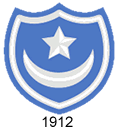
Portsmouth's famous crest, consisting of a crescent moon and star made its first appearance in 1913. The moon and star motif comes from the town's coat of arms and are believed to date back as far as the time of Richard I. Curiously, the star on the original badge featured a star with five points rather than the eight that appear on the town crest.
In 1920 the First Division of the Southern League was incorporated into the Football League as the Third Division and Portsmouth duly took their place. Their manager, John McCartney, had predicted promotion within three seasons and sure enough, in 1924 the club won the Third Division (South) title. On the last day of the 1926-27 season a late goal allowed Portsmouth to pip Manchester City for promotion to the First Division on goal average by 0.02 of a goal. This was the first time that a Third Division club had reached the top level. After two seasons fighting relegation, Portsmouth began to establish themselves, reaching the FA Cup final in 1929 and 1934.
According to Pompey People FC Who's Who 1899-2000 (Mick Cooper 2000), Jimmy (Nicholl) was at the club when the pitch was completely returfed in the summer of 1930 and was one of the first to wear the darker blue shirts which were adopted for the 1933-34 season.
In 1939, Portsmouth met a strong Wolves side in their third FA Cup final as rank outsiders but this time they won by 4-1.
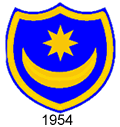 During the Second World War Portsmouth put out strong sides because of the many servicemen stationed in the port who had been professional footballers in peacetime. It was in recognition of the club's association with the armed forces that the distinctive red stockings were adopted in 1947. It also seems that the eight-pointed star appeared at the same time. In the immediate post-war period, Pompey were a formidable side and won the First Division championship in 1949, their jubilee season, and in 1950.
During the Second World War Portsmouth put out strong sides because of the many servicemen stationed in the port who had been professional footballers in peacetime. It was in recognition of the club's association with the armed forces that the distinctive red stockings were adopted in 1947. It also seems that the eight-pointed star appeared at the same time. In the immediate post-war period, Pompey were a formidable side and won the First Division championship in 1949, their jubilee season, and in 1950.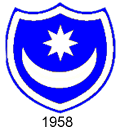
During the 1950s and 1960s, the club crest was amended slightly and now featured white rather than gold embroidery, no doubt a cost-saving measure.
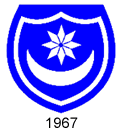 Failure to find replacements for aging players led to gentle decline throughout the 1950s culminating in a series of disastrous seasons that took the club all the way down to Division Three in 1961. Although they won promotion at the first attempt, Pompey spent the next 13 years in mid-table obscurity in Division Two. A slightly amended crest was used between 1967 and 1973.
Failure to find replacements for aging players led to gentle decline throughout the 1950s culminating in a series of disastrous seasons that took the club all the way down to Division Three in 1961. Although they won promotion at the first attempt, Pompey spent the next 13 years in mid-table obscurity in Division Two. A slightly amended crest was used between 1967 and 1973.
The late Seventies brought serious financial problems and Portsmouth slipped into Division Four in 1978.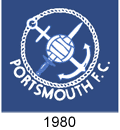
The team's recovery started with promotion back to the Third Division in 1980. The following season a new crest was introduced that featured an anchor and a sword to symbolise the city's links with the Royal Navy and the Army respectively. Two versions appeared one of which had at its centre a football while the other replaced this with a small version of the crescent moon and sun.
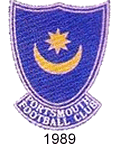 The club, often described as the "sleeping giant on the South Coast" won the Third Division championship in 1983 and in 1987, Pompey returned to the First Division, albeit briefly - they were relegated in 1988. The unpopular crest introduced at the beginning of the decade was retired the following season and replaced by the traditional badge with the addition of a small crest bearing the club's name.
The club, often described as the "sleeping giant on the South Coast" won the Third Division championship in 1983 and in 1987, Pompey returned to the First Division, albeit briefly - they were relegated in 1988. The unpopular crest introduced at the beginning of the decade was retired the following season and replaced by the traditional badge with the addition of a small crest bearing the club's name.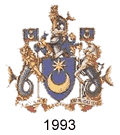
In 1992 Portsmouth reached the semi-finals of the FA Cup and the following season they reached the play-offs.
In 1993 the board decided to adopt the Portsmouth coat of arms as their club crest. This proved unpopular with supporters, many of whom thought the new badge too elaborate. After four years the board bowed to public pressure and the 1989 crest was reinstated.
During the club's centenary season a financial crisis led to administration in December 1998. At this time there was no points penalty for clubs who took this course and Portsmouth retained their place in the second tier before Milan Mandarić bought the club in May 1999. Mandarić appointed Harry Redknapp as manager in 2002 and invested a considerable sum in pursuit of success. In 2003 Pompey were promoted to the Premier league as Nationwide Division One champions. Redknapp resigned half way through the 2004-05 season after a row with his chairman, and moved down the coast to manage Portsmouth's arch rivals Southampton. Less than a year later Redknapp was back and in January 2006 the club was bought by Alexandre Gaydamak, who funded record transfer dealings as Redknapp assembled a brand new squad.
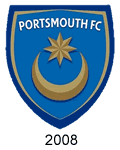 The climax of the 2007-08 season was a return to Wembley where Pompey narrowly beat Championship side Cardiff City, to win the FA Cup for the first time since 1939. Success on the field was, however, achieved by generating huge debts, which would bring the club to the brink of extinction.
The climax of the 2007-08 season was a return to Wembley where Pompey narrowly beat Championship side Cardiff City, to win the FA Cup for the first time since 1939. Success on the field was, however, achieved by generating huge debts, which would bring the club to the brink of extinction.
The following season, Pompey celebrated their 110th anniversary, adopting a new crest and an all blue kit trimmed in gold.
In May 2009 Gaydamek sold the club Sulaiman al-Fahim, a businessman from the United Arab Emirates who promised to invest £50m in the club. In fact there was no new money and in October al-Fahim sold 90% of his holdings, including several pieces of real estate near Fratton Park, to a Saudi-based businessman, Ali al-Faraj who had been behind a rival but unsuccessful bid to buy the club in May. Once again, it turned out that the new owner did not have the cash needed to keep the club running but the group fronted by al-Faraj did persuade Hong Kong based Balram Chainrai to loan the club £17m. In October Daniel Azougy, an Israeli lawyer with a conviction for fraud, was appointed to restructure the club's debts, estimated to be around £60m.
Faraj was late paying the players and staff for November, December and January and the Premier League slapped a transfer embargo on the club for unpaid transfer fees. In December HM Revenue & Customs took out a winding-up order to recover unpaid VAT and PAYE. On 4 February the club, now rooted at the foot of the Premier League, was taken over by Chainrai, exercising his option to take control if loans he had made to the club were not repaid.
At the end of February 2010, Portsmouth became the first Premier League club to go into administration, suffering a nine-point deduction that virtually ensured their relegation. In his initial report the administrator estimated the club's debts to be around £80m but by the middle of May, this had risen to £140m. Remarkably, Portsmouth's season climaxed with an appearance in the FA Cup final where they were beaten by Chelsea.
